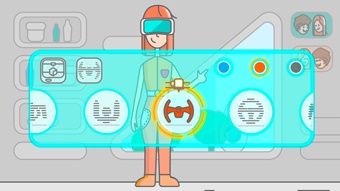Almost everyone has a smartphone these days, this is an example of something that is touch sensitive, the screen. Such sensors are expensive to manufacture and are usually only available on flat surfaces no bigger than a computer screen. What if it were possible to create an entire wall in your home into a giant touch screen at an affordable price? Now, thanks to three researchers from Carnegie Mellon University, Chris Harrison, Geirad Laput, and Yang Zhang, it’s possible. Their new method, known as Electrick, is based on using electric field tomography technology and conductive materials, hence the name. In their video they show how easy and fast it is to use, giving examples of applying it to a steering wheel, a guitar, a wall, or even something that has been 3D printed.
How It Works
In just two simple steps, we will show you how to turn an object into a touch sensitive one.
- First, spray your object with conductive coating
- Secondly, add sense electrodes to the periphery of the intended sensing area
If you’d like, you can top coat the object for an extra layer of protection. Now your object will be able to detect the touch locations and even follow a continuous touch, such as swiping your finger on a phone’s screen.
Now for the best part, you can even 3D print an interactive object using FDM technology. You will need to print your product using carbon loaded ABS and add the electrodes to it as explained above.
The team also showed us how to mold such objects by mixing carbon fiber and conventional silicone, or by making a conductive coating using Velostat. The trick lies in the conductive material, which can be applied to an object and injecting a small electric current into it. By attaching the electrodes to the object is what creates the current and then the area in which you touch it can be detected by measuring the potential difference between the pairs of electrodes around the whole perimeter. Also, the computer program can turn these measurements into a 2D image. You can read the full description on how to make a low-voltage current.
Practical Uses and Prices
The researchers who created Electrick have also developed computer and smartphone applications to show where the sensors can be used. As an example, they turned a desk into a panel with laptop controls, added a light regulator to a wall in a house, created some interactive toys and also enabled the technology to be used in jelly and play-doh figures.
“The total cost of our hardware is $70, which could be made both smaller and less
expensive in a high volume commercial application”, - says the team in their study, presented at Conference on Human Factors in Computing Systems this week in Denver, Colorado. “We believe this work can bring touch interactivity to new classes of objects, as well as enable designers to rapidly prototype objects with innate interactive capabilities.”
Our blog is also available for anyone with interesting story or useful life hacks, just write to us: press@treatstock.com
Поделись с друзьями:






